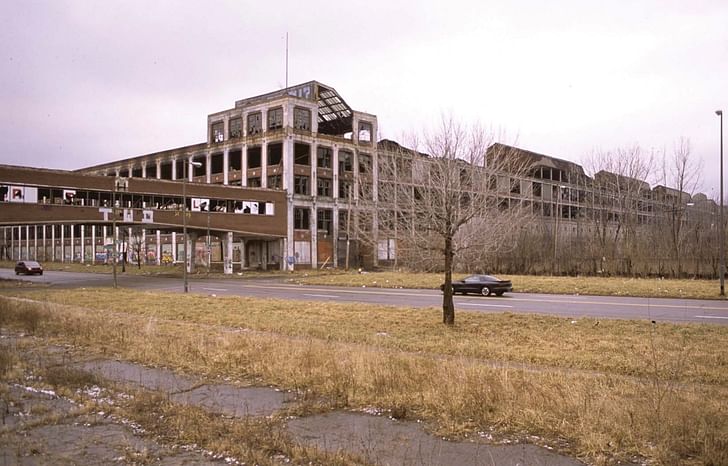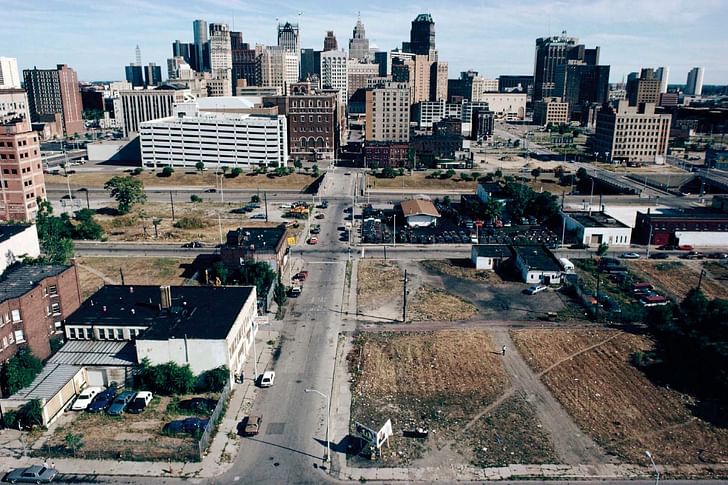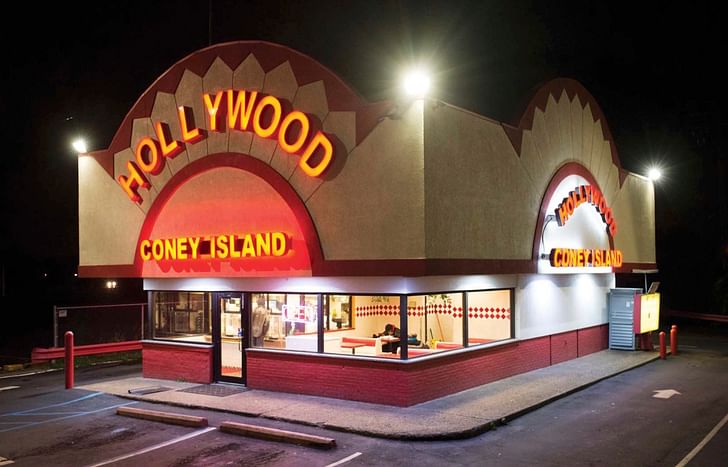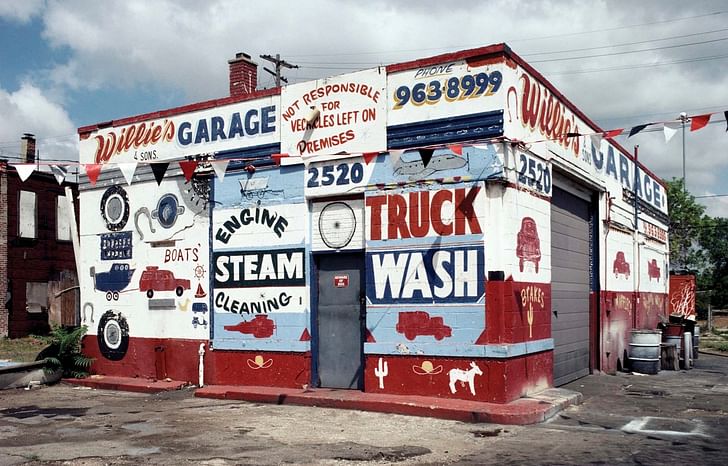

Detroit, once one of the 20th century’s top three thriving U.S. metropolises, has been a case study in ruin and decay for nearly half a century. “Detroit is No Dry Bones: The Eternal City of the Industrial Age,” a new book of photographs and nuanced essays by Camilo Jose Vergara, delves into this culture of ruin, offering architects and urban planners an intriguing (and often surprising) pictorial atlas of what happens to a civilization during uncivilized times.
In Detroit, the distinction between a city block and wild acreage is rarely clear. Meticulously maintained single family homes sit next to collapsing heaps, long stripped of their aluminum siding and copper piping by thieves hoping to make a buck at the scrap-yard. At least one generation has never known inner-city Detroit It's a place where repurposing, not only of architecture, but of traditional urban identity and culture, has taken on cunning life as anything other than capitalism’s cautionary tale, a 130-square mile island of poverty in an ocean of suburban wealth. According to “Detroit is No Dry Bones,” it’s a place where people don’t stop for gas on the city side of Eight Mile for fear of being mugged. But it’s also a place where repurposing, not only of architecture, but of traditional urban identity and culture, has taken on cunning life.

Intriguingly, Vergara does not take the stance that demolition of ruin is automatically a good thing, arguing that some of these dilapidated structures, and the artistic and social change that comes out of them, constitute a worthwhile culture. He examines the work of the painter Tyree Guyton, whose ubiquitous Like the flourescent lighting of repurposing, Dryvit has a bright if not necessarily aesthetically pleasing effect red and black dots painted across crumbling walls and abandoned billboards framed the city anew. “Officials disliked his work because it drew attention to decay and taught viewers who had grown used to dereliction to take a fresh look at their surroundings,” Vergara states, before noting that many of Guyton’s works have been purposefully bulldozed. Just as every unhappy family is unhappy in its own way, so every site of decay seems to display its own signature blend of ruin, some of which are invariably shot through with beauty. There are the dozens of murals to the city’s dead that crop up on the sides of auto repair shops, lampposts, and fences. Paired with paintings of long gone drug dealers and children killed via stray gunfire, Vergara observes that “on the east side of Detroit, on a fence facing Woodlawn Avenue, there are more than twenty poster-sized memorial portraits of people who once lived in the neighborhood.”
For architects, the widespread decay of a steel and glass city offers insight into what happens to a contemporary metropolis when money for maintenance is suddenly absent. “Unlike ancient ruins that were built brick upon brick or stone upon stone and can last for thousands of years, modern ruins are supported by steel armatures that can rust, and water infiltration will corrode the clips that hold the cladding. When water freezes between the cladding and frame, the resulting expansion loosens the coverings and they collapse.” The subsequent repurposing of more solid structures, including the French Renaissance-style Michigan Theatre whose ornate ceiling now looks down on a parking lot, is therefore both inventive and shocking. It creates a tangible culture of dissonance, a weird alchemy that refuses to ever really settle into a coherent style. The book takes a look at banks in particular, which “outlive the rest of the buildings on the block, going on to become churches, fast food restaurants, community organizations, and even gentlemen’s clubs.” The book features a photo of Jaye Dee’s market on Hamilton Avenue, formerly the Detroit Bank and Trust, which has repainted its once staid doric columns with “red for the blood of the people, black for their skin color, and green for the land.”

Widespread repurposing has taken a specific material form known as Dryvit, a pliable, inexpensive cladding that can be easily shaped into turetts, arches, and other cosmetic forms. Like the flourescent lighting of repurposing, it has a bright if not necessarily aesthetically pleasing effect on the buildings it temporarily freshens up. As Vergara describes it, “new and refurbished fast food franchises, gentleman’s clubs, churches, liquor stores, marijuana dispensaries, and convenience stores, dressed up in foam with a shell surface, are covered with strange, exaggerated shapes.”

Renewal takes many forms, of course. While there are many new artists flocking to the city from around the globe to take advantage of cheap real estate on an arresting apocalyptic canvas, many of the long-term residents complain that there is no real connection between this new wave of art and the people. A tribute to the street artist Nekst by New Zealand artist Askew One that featured a man carrying a knife was later partially covered up the owner of the brick-and-mortar store on whose wall it was painted when the city threatened to ticket her for the display. "I wasn't going to pay no ticket," the owner told Vergara. The result is a strangely amputated figure on a field of white-washed brick.

Downtown Detroit, which for decades functioned as a kind of art deco skyscraper graveyard, is still largely the standby meme of urban abandonment, shocking not only for its dereliction, but the speed of that dereliction. In less than a half century, the city went from being New York and Chicago’s rival to a place that became a central focus of this book’s author, who wished to document “the new American ghetto.” It doesn't take long for a beaming city to wink out into ruin But what exactly is this ghetto, and what does it portend for the future of American cities? Combine a lack of intelligent infrastructure spending with a general disregard for humanity, and you might just wind up with the rotted, hollowed-out, fire-hazard block party of Detroit. After struggling with the bankruptcy, the city just recently restored many of its traffic signals, which for decades did not function at night, leaving multiple-lane intersections illuminated only by the glow of trash-can fires. But Detroit, although extreme, is hardly an urban anomaly: as this book richly demonstrates, it doesn’t take long for a beaming city to wink out into ruin.
Julia Ingalls is primarily an essayist. Her work has appeared or is forthcoming in Slate, Salon, Dwell, Guernica, The LA Weekly, The Nervous Breakdown, Forth, Trop, and 89.9 KCRW. She's into it.
2 Comments
Detroit should open a university in one of these abandoned places to educate people about how to restore old homes and other buildings and lead the world in repurposing an entire city!
They would first have to establish a faculty of architects and construction experts to teach the skills.
Ask Home Depot and Lowes to pitch in too!
Detroit - abandoned by industry, ignored by government, and repeatedly shorted by “developers and entrepreneurs“ is a glimpse into the not-to-distant future for many cities and citizens.
Block this user
Are you sure you want to block this user and hide all related comments throughout the site?
Archinect
This is your first comment on Archinect. Your comment will be visible once approved.